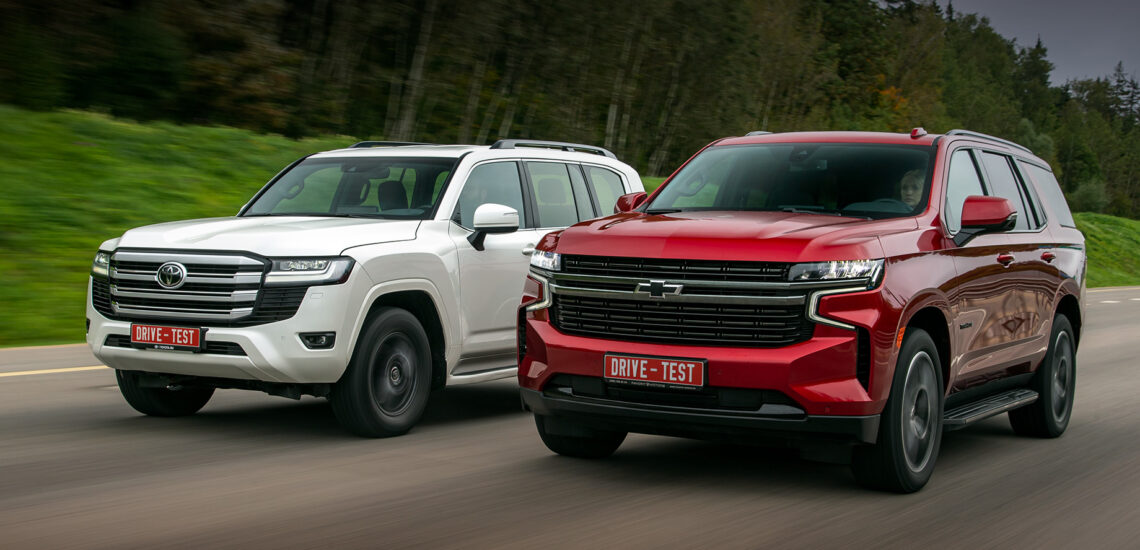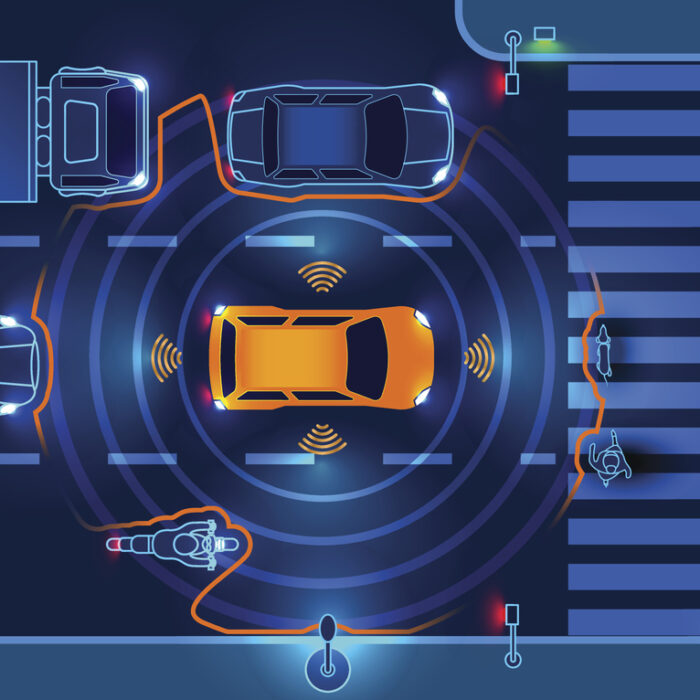你看到过所有 Land Cruiser 前任车主在观看第 300 辆 Land Cruiser 时脸上的表情吗?孩子们从来不会用那种眼神看糖果!忠实的观众已经接受了新的(不那么野蛮的)外观,就像他们对 V8 的缺席并不感到惊讶一样。没有人质疑过 Cruiser 的驾驶能力,尽管他们应该质疑。然而,Land Cruiser 300 不仅保留了所有的越野能力,丰田还改进了城市和平地驾驶。雪佛兰 Tahoe 也有同样的变化。Tahoe 的框架与 Cruiser 一样,但不同之处在于雪佛兰采用麦弗逊式独立悬架,而丰田采用独立双叉臂前悬架。
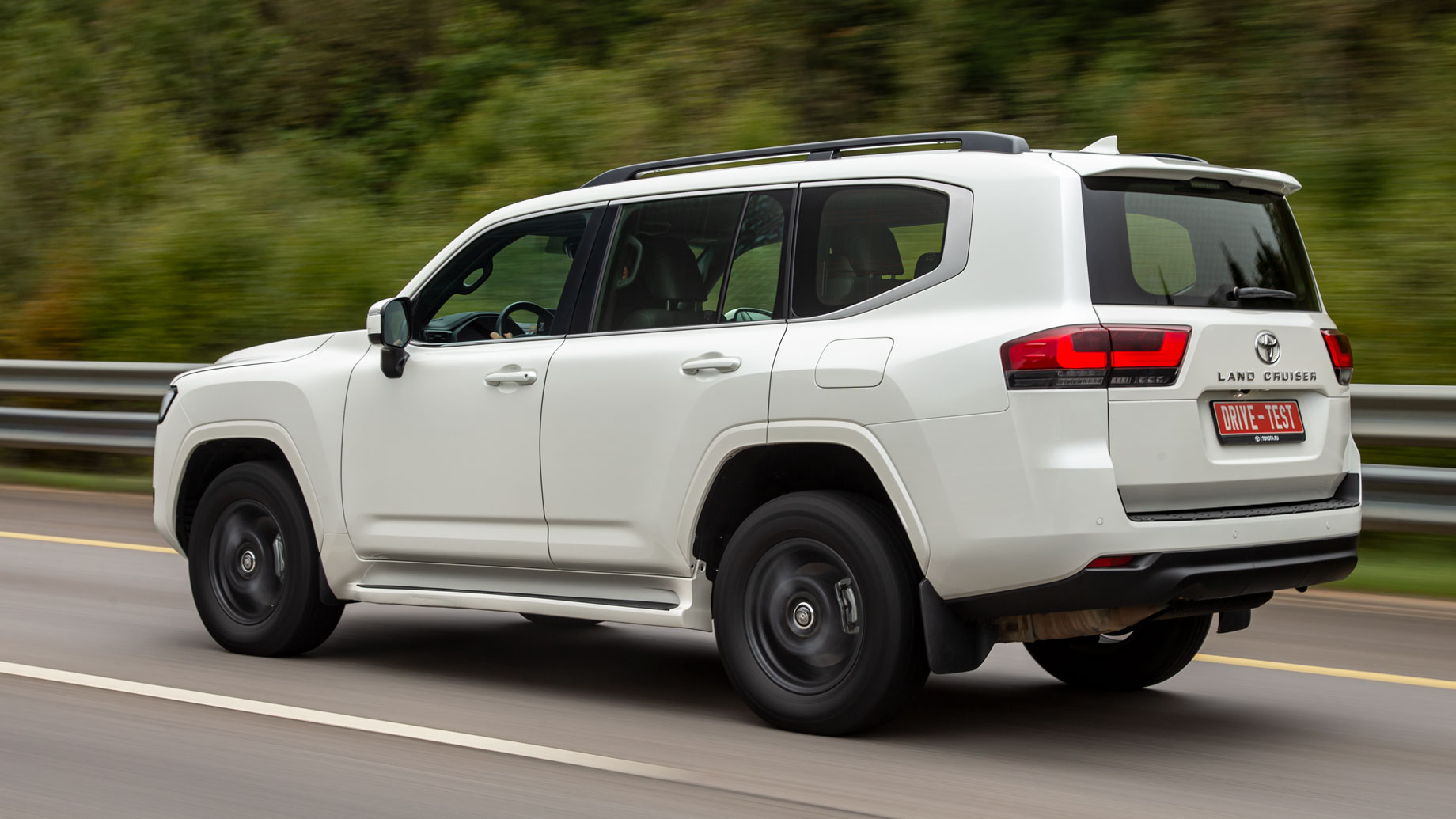
Land Cruiser 300 的进气口令人眼前一亮,它包裹着有趣的散热器格栅底部。大多数外部车身面板都是铝制的,下面是更坚固的车架和重心更低的 GA-F 底盘。
这辆车减重了 440 磅,但尺寸保持不变。长度增加了 1.5 英寸,高度减少了 1.18 英寸,宽度和轴距保持不变。只有高度减少了 30 毫米,但这并没有影响登车过程。我抓住前柱上的扶手,小心翼翼地站在脚踏板上,以免弄脏,我坐得比 200 系列更舒服。
方向盘倾斜度更小,可以在比以前更长的肩部上调节。座位现在更低了——双腿弯曲得更少了。你可以踩下踏板,而不是踩在踏板上。然而,座椅仍然很高——即使你将座椅放低到最大,你也会看到,它是一个宽大的引擎盖,中间有一个典型的空洞。即使是长途旅行,驾驶员座椅本身也没有任何问题。虽然独特的侧向支撑、枕头延伸和腰部支撑的垂直调节会派上用场。
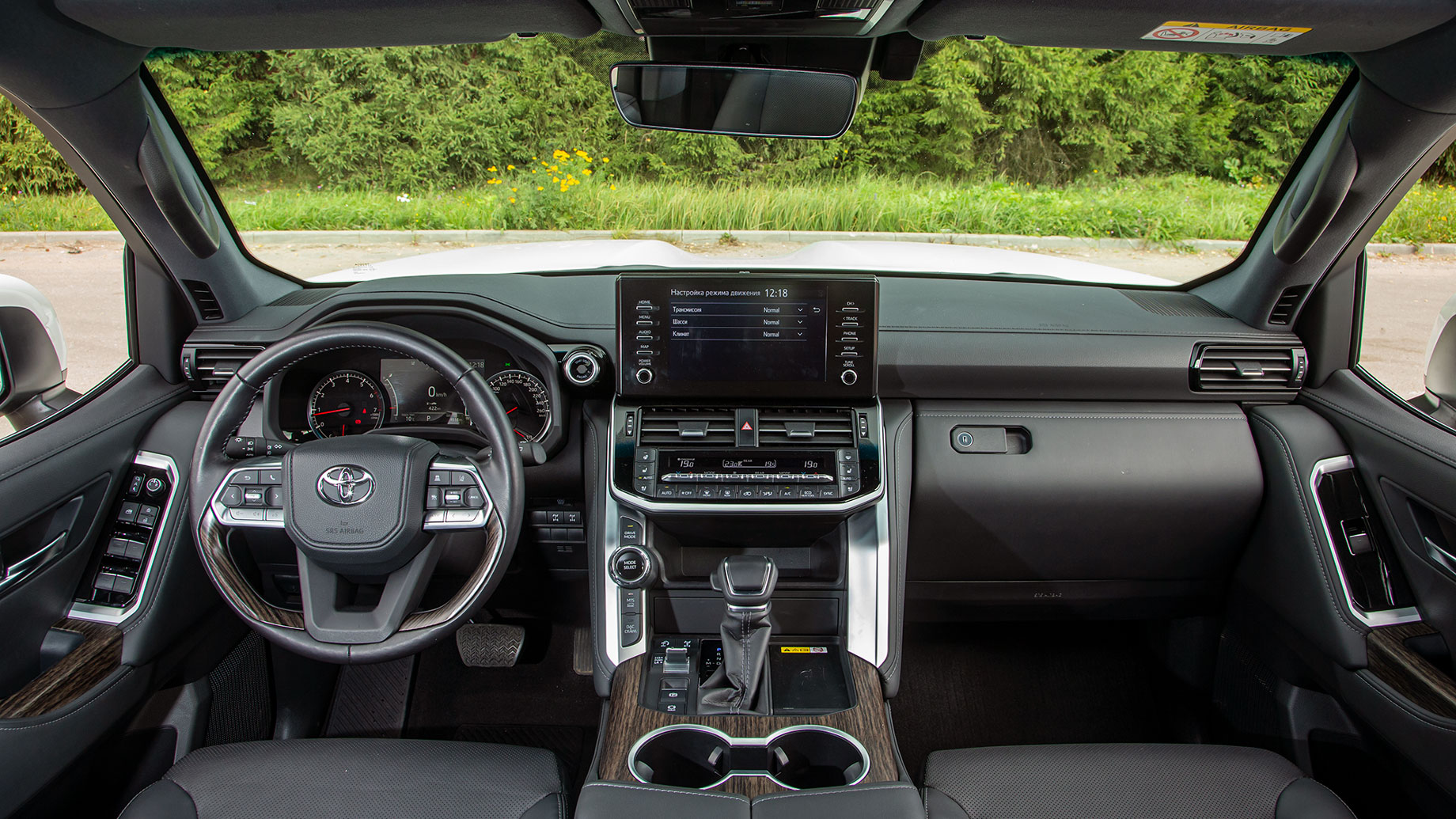
方向盘不会在整个轮辋上发热,您可能找不到比丰田更差的木质饰面。多媒体在这里是个特例。新的宽屏显示器只允许在 Land Cruiser 70th Anniversary 和 GR Sport 中使用,而 Comfort+ 则有一个过时的系统,它反应相当慢,屏幕分辨率低,图形来自过去。然而,优点包括方便的触摸屏配置、大字体和与智能手机的快速蓝牙连接。
Land Cruiser 的外观令人印象深刻,但雪佛兰 Tahoe 总的来说是有效的。特别是 RST 运动版,配备 22 英寸车轮(Cruiser 为 18 英寸)、越野 Z71 搭配全地形轮胎、车身底部保护、改进的几何通过性和外露的前牵引点。
驾驶员在 Tahoe 感觉比在丰田车上舒服得多。座椅较低,更能保持身体形状。它有更大的座椅调节范围,坐垫更长,虽然没有延长器。方向盘更加直立,没有木质嵌件,这使其触感更加舒适,宽大的中央扶手位置也更好。总的来说,只有一件事妨碍了 Tahoe 的舒适坐姿——双脚相对于小腿弯曲得更多。可调节踏板组件可以解决这个问题,但这里没有。
除此之外,位于速度表和转速表之间的显示屏向我们展示了四个虚拟表盘,由于尺寸小且图像模糊,很难读取。变速箱控制单元位于方向盘下方,就在您的右手应该放的位置旁边,这非常方便,但为什么有些按钮您必须按下,而其他按钮则需要半拉呢?中央控制台按钮和唯一的一个转向不足开关需要一些时间来适应。
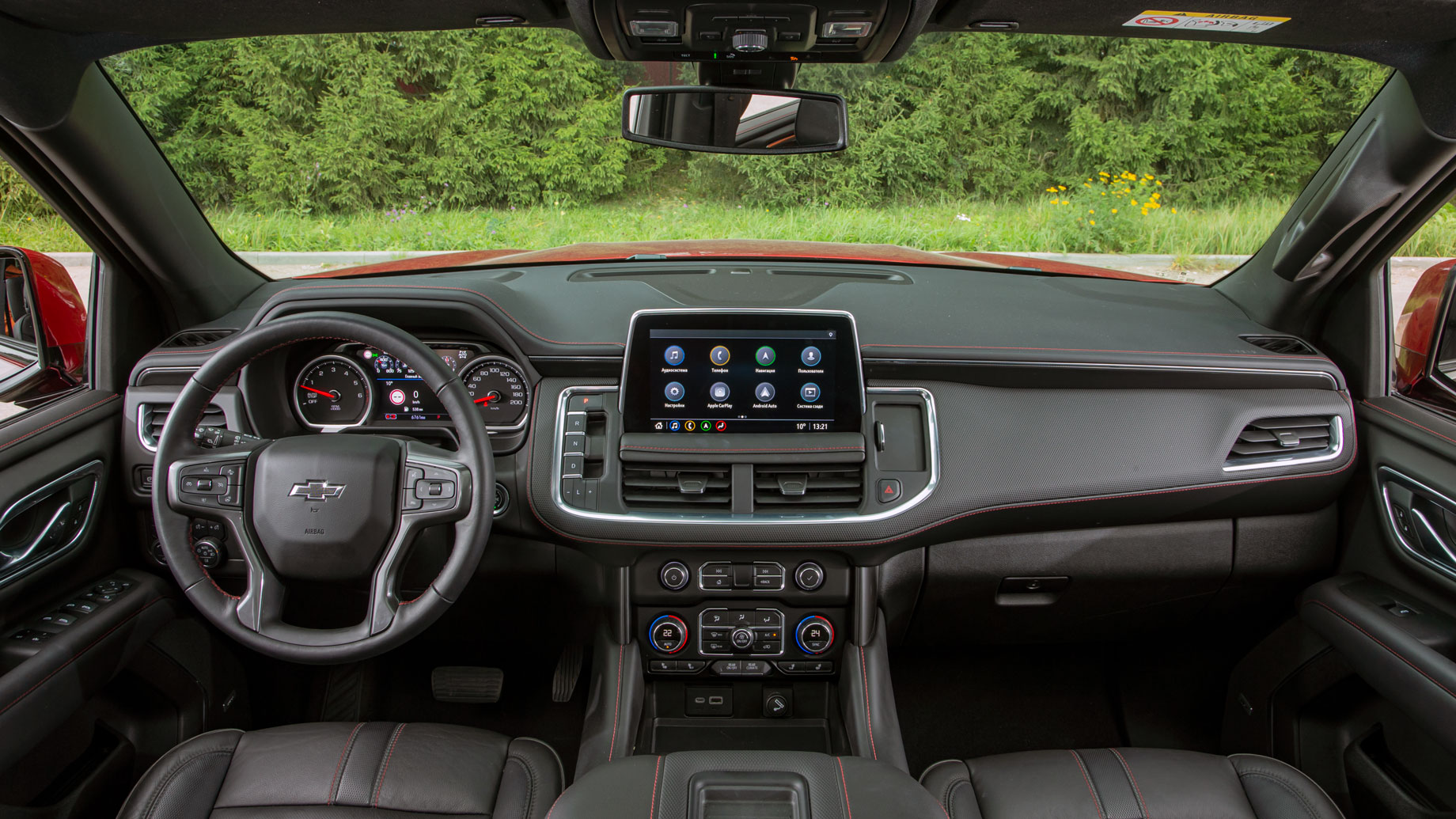
Tahoe 的多媒体比丰田好得多。更大的十英寸触摸屏具有更高的分辨率,触摸反应更快,即使使用导航地图操作也能流畅运行。与智能手机的蓝牙连接速度较慢,但有线 Android Auto 更稳定。雪佛兰允许您付费订购后排乘客娱乐系统。
即使没有这个系统,Tahoe 也能为后排乘客提供更多娱乐。后门开口更大,地板更低,如果需要,车身会靠空气弹簧落到地面。带有软垫的独立座椅纵向移动,其坚硬的靠背可以倾斜到相当大的角度。雪佛兰的几何形状更好,自由空间更大。头顶空间比丰田的要小,但仍然足够。在我膝盖前面(我的身高是 5’9),边缘是丰田的两倍——高达 5.12 英寸。 Tahoe 的头顶空间较小,但仍然足够(3.15 英寸 vs 4.33 英寸)。
如果 Tahoe 有三人座沙发,您必须移动它才能到达后座。在这种情况下,这是没有必要的——分开的座位可以让您自由移动。座位几何形状不会破坏愉快的体验,中间座位可以调整,以便每个人膝盖前面都有足够的空间。在后排,我坐下来的间隙高达 4.33 英寸,头顶的间隙为 1.57 英寸。对于乘客来说,有几个杯架和 USB-C 连接器。
第二排的 Land Cruiser 提供了足够的空间,还有双区气候控制,而不是 Tahoe 的单区。增加沙发的舒适度会很好:皮下的填充物太密,不会沿纵向移动的枕头比我们希望的更靠近地板,并且背部是平的,尽管它可以调节倾斜角度。这款售价 84,000 美元的车也没有加热座椅,尽管雪佛兰默认配备加热座椅。事实上,即使是售价 72,000 美元的基本款 Cruiser 也没有加热前排座椅。
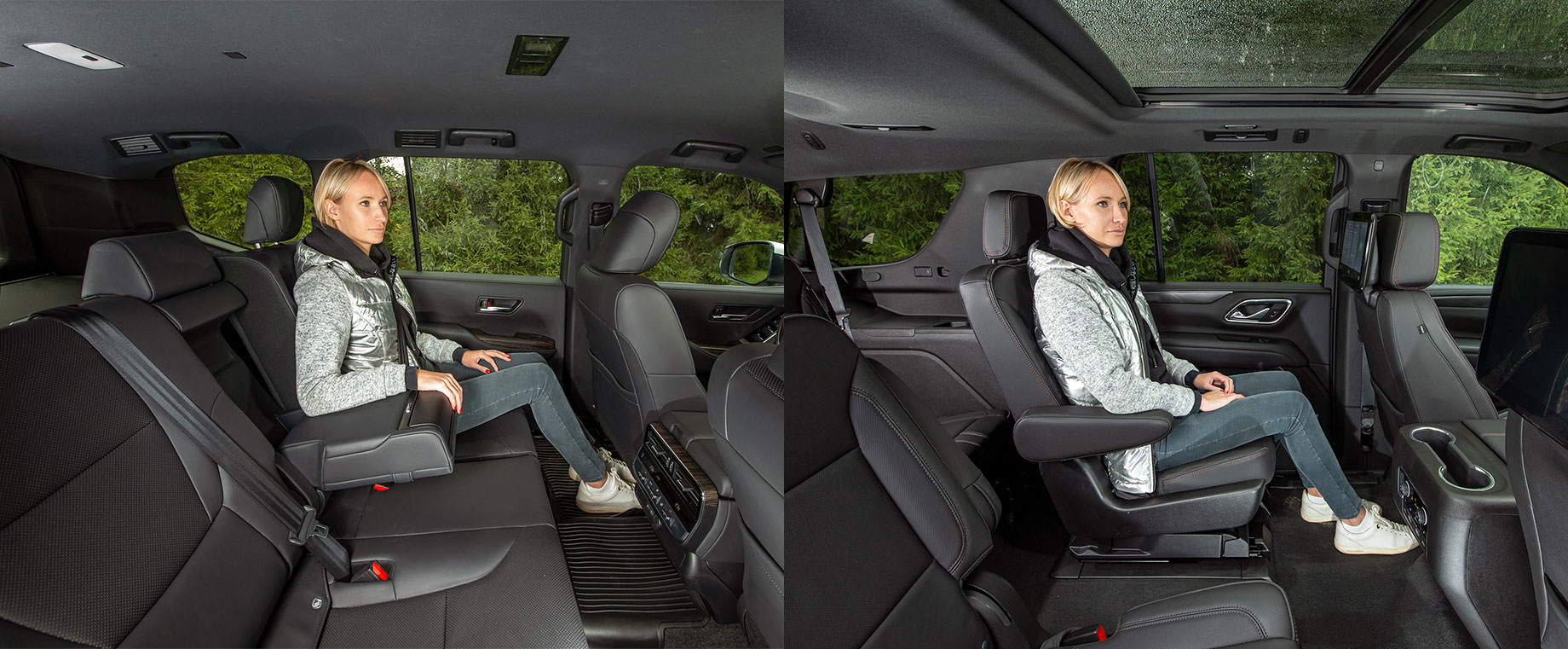
启动时,汽车抬起车头,突然向前跳跃,仅需 6.9 秒即可从 0 加速到 100 公里/小时,综合油耗为每 100 公里 8.9 升。它比之前的型号快 2 秒,这是通过用相同数量的涡轮增压器补偿两个气缸实现的,因此发动机可产生 415 马力的功率和 650 牛米的扭矩。
市面上有更快、更强大的 AWD 汽车,但 300 仍然是最好的之一。在城市拥堵中,即使是舒适模式也足够了。油门和刹车踏板反应柔和,但仍然很快,足够了。在正常设置下,轴流泵响应更快,Sport S 设置可能就足够了——CUV 跟随油门踏板,就像在刚性离合器上一样。但它仍然有一个更强大的 Sport S+ 模式,你应该只在实验时试驾。
即使是十速 AGB 也不会破坏驾驶这辆车的轻松感。尽管它尝试过。在交替负载下,变速箱经常会在齿轮中出现混乱,将它们放在错误的位置。向下过渡伴随着明显的停顿,尤其是在需要跳过几个范围时。但情况并不那么危急,这就是为什么——强大的引擎可以完成工作。
当我启动 Tahoe 引擎时,我笑了——多好的声音啊!深沉,在 2000-3000 rpm 时沸腾,在接近转速表红区时野蛮咆哮。不过,最好还是拉动以匹配咆哮声……踩下油门加速后,Racelogic 在 8.6 秒内加速到 100。这比护照值慢了六分之一,与丰田的差距非常大。陆地巡洋舰像绒毛一样被吹走了,雪佛兰加速就像在鞭子下一样。
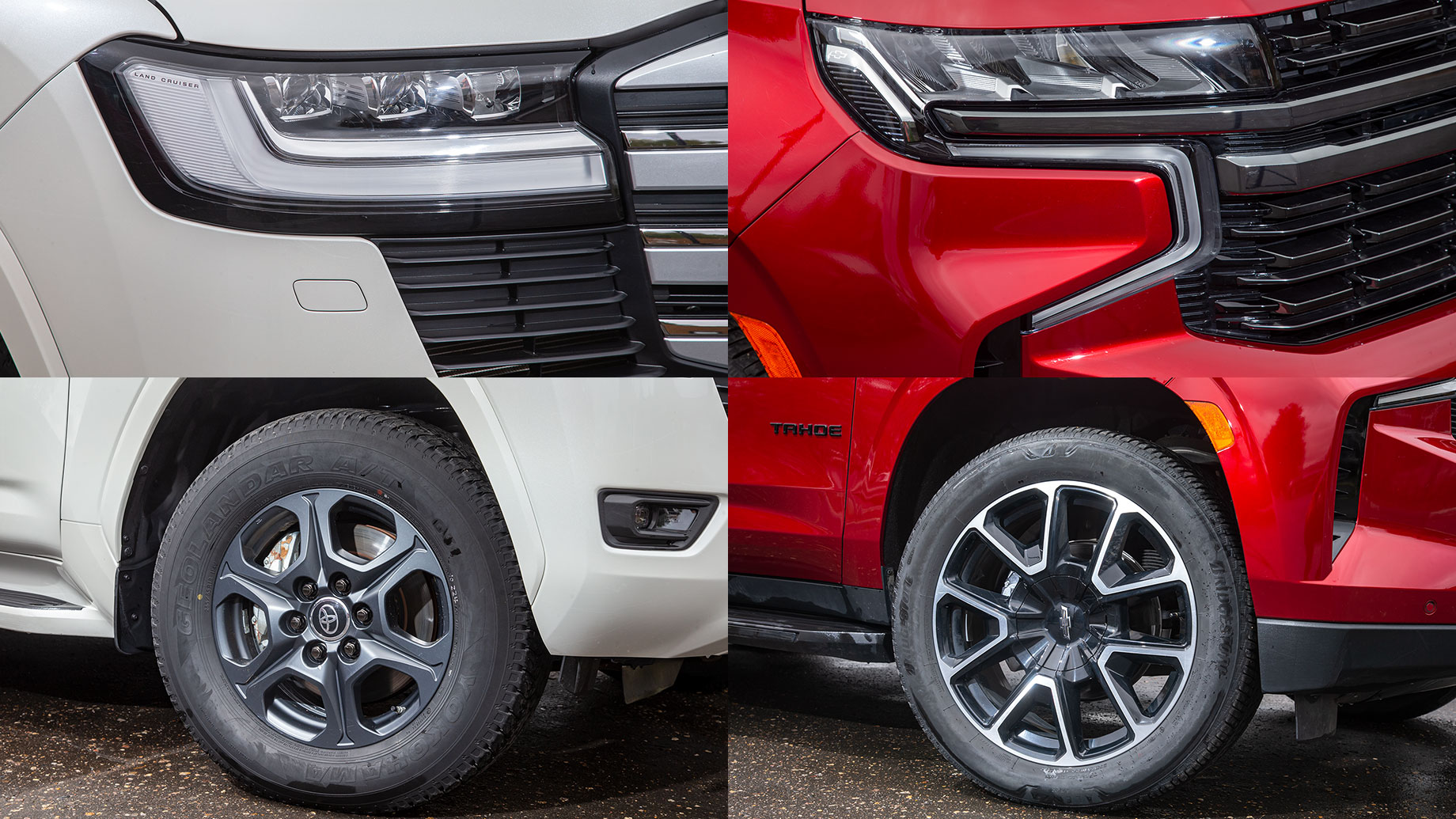
一旦曲轴加速到 5000 rpm 及以上,Tahoe 就会变得更加灵敏、更快,并且在乡村道路上有更多动态超车的机会。尽管如此,在 120 km/h 或更高时,雪佛兰还是有点疲惫。另一方面,Land Cruiser 在 150 km/h 或以上时感觉很好。
Tahoe 的无聊感因阻尼加速器而加剧,它在冲程的前三分之一非常迟缓。您可以通过运动模式和更高的发动机转速来使其多样化,但即使这样,Tahoe 也没有达到 Land Cruisers 的水平。变速箱与丰田变速箱有同样的问题,但工作速度更慢——它很容易在十速变速箱中迷失,并且需要时间来思考是否要接合低速档。换档也大致如此,尽管比 Cruiser 的换档更平稳。
至少,雪佛兰底盘更精致。非悬挂质量的振动更少,没有横梁轴特有的冲击,能量强度增加了。即使在深坑中,行程也感觉很好,边缘锋利。我只希望车身不要在路况不好的路段左右摇摆。
Tahoes 的控制发生了明显的变化——它是一辆汽车,而不仅仅是一辆卡车,就像以前一样。雪佛兰反应灵敏,在蜿蜒的道路上愿意换挡,在高速弧线上顽强保持,无论路面质量如何。车身侧倾很大,但可以通过运动模式避免,运动模式会压缩自适应减震器和空气弹簧。唉,锋利的方向盘也毫无意义地重。在正常模式下,不会分配任何信息,但通过下垂,它仍然可以绕过拆除的开始。顺便说一句,它会很快被稳定系统停止,稳定系统可以在最高 19.8 英里/小时的速度下关闭。
丰田汽车在高速驾驶方面很有意思:方向盘的反应有点急躁,转弯时速度更快,漂移阶段很快被四个车轮的打滑所取代。即使是巡洋舰的保险电子设备也设置得更自由,如果需要,可以完全停用。然而,巡洋舰的侧倾更严重,其纵向振动更明显。悬挂运动模式几乎没有希望——它破坏了乘坐舒适性,而不是使汽车更加装配。
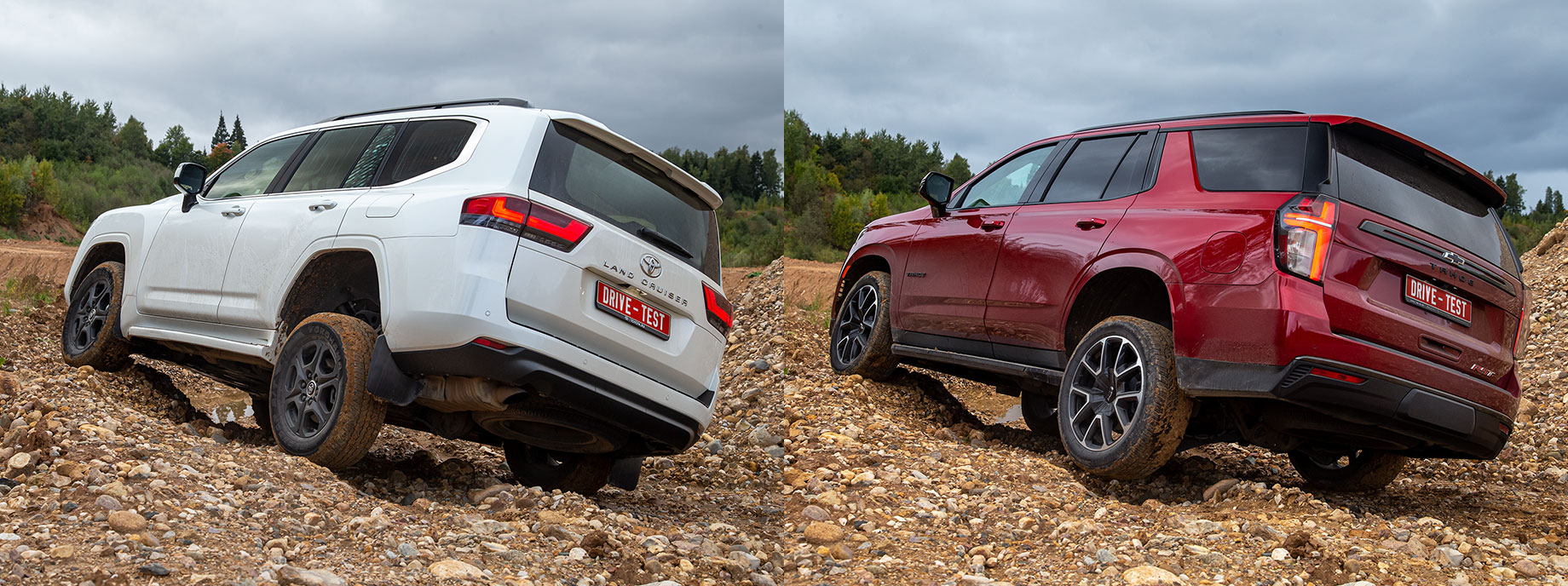
悬架舒适性方面的问题已经够多了。陆地巡洋舰大部分时候都比较颠簸,尤其是在中型和大型坑洼上。在平坦的道路上,Cruiser 300 总是会找到颠簸的原因。后悬架以它独特的方式抽搐——在 9.3-12.4 英里/小时的速度下,在人为颠簸时速度更快,它会把后座乘客甩起来。至少,由于双侧窗和更好的轮拱隔音效果,车内明显更安静。
你会在越野时看到所有这些改进。在颠簸的路面上,陆地巡洋舰飞驰而过,以至于 Tahoe 被尘土掩埋。没有违反规则,悬架没有颠簸——在崎岖地形上的表现堪称典范。如果丰田可以毫不费力地保持 37-43 英里/小时的速度,那么对于雪佛兰来说,即使 25 英里/小时也太多了。悬架在压缩和回弹过程中都会发生敲击、碰撞。更不用说前保险杠唇和后控制臂了……
然而,Tahoes 空气悬架不仅可以保持间隙并放气,而且在必要时还可以将车身升高 50 毫米。我们在沙地、泥泞的泥浆上行驶,在湿滑、松散的涂层下被迫爬坡,但汽车没有在任何地方扎根。那些他们无法从原地拿走的障碍物在低速时被克服了。当我们拉出陆地巡洋舰时,最需要降低行距,将其固定在腹部。
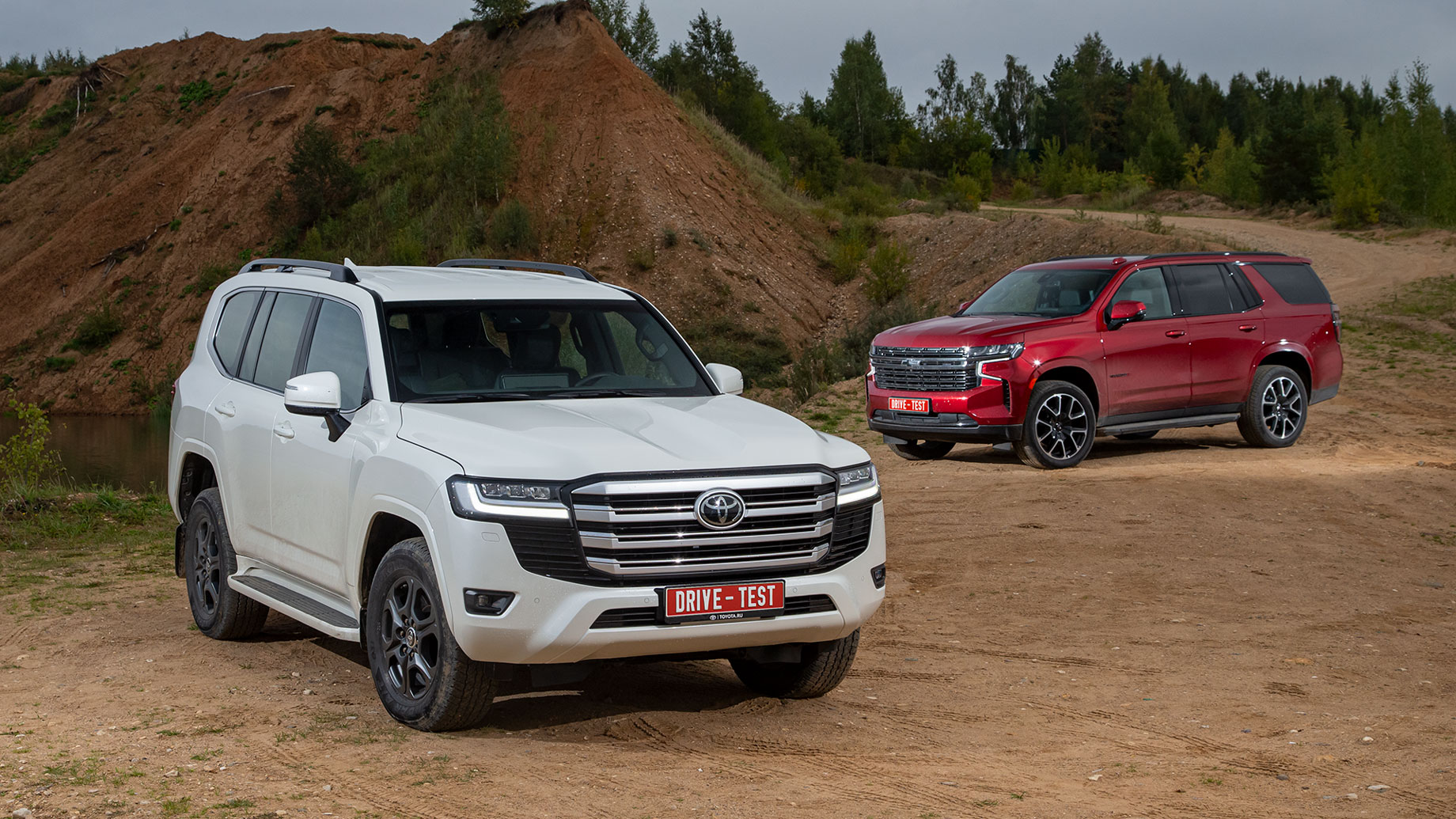
我们驾驶丰田汽车穿过泥土。我们一直在危险的地区犁地很长时间,直到我们自然而然地落在软粘土下的高而硬的弯道上。然而,不要让这个初步结果欺骗你——真正的 SUV 是 Land Cruiser 300。它具有更大的离地间隙、更好的几何通过性和更智能的电子设备。它不是耐力型前电磁离合器,而是恒时四轮驱动。所有三个差速器都可以强制锁定,而 Tahoes 的后差速器仅由电子设备控制。
重心更靠近地面,加上调校的悬架,让 Land Cruiser 的步伐更加自信。令人惊叹的双涡轮汽油发动机为丰田带来了全新的动力水平。这款框架非常紧凑的 SUV 在越野时比在硬路面上感觉更舒适。不过,有了出色的隔音效果,让柏油路行驶更平稳就太好了。毕竟,Land Cruiser 300 的大部分生命都将在城市中度过。
Tahoe 似乎比丰田更完整。不过,Cruiser 的平静大气的 V8 发动机与平衡的驾驶特性和高水平的舒适性完美结合——内部空间宽敞舒适。非常适合家庭用车!然而,与海外版 Tahoe 相比,廉价的内饰和精简的设备清单破坏了这种印象。
這是翻譯。您可以在這裡閱讀原文: https://www.drive.ru/test-drive/chevrolet/toyota/6169a811c083e6637ae3a79e.html

出版 三月 17, 2022 • 4m

